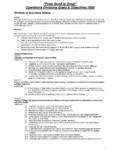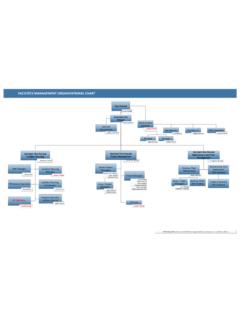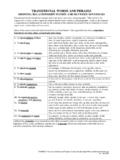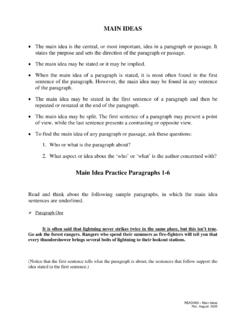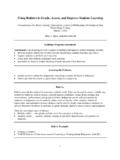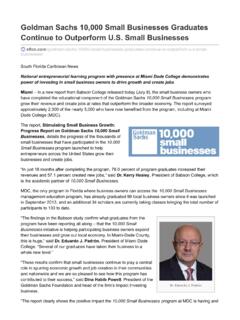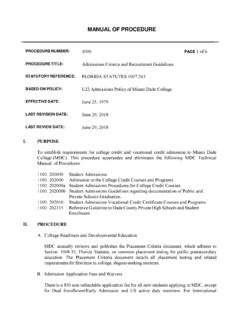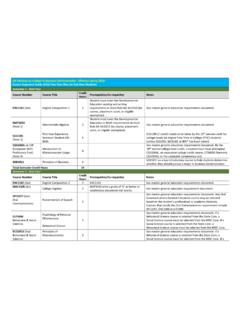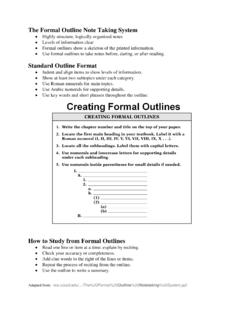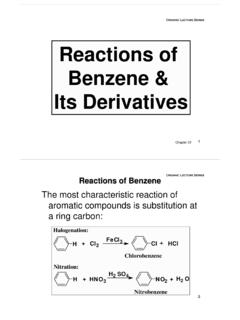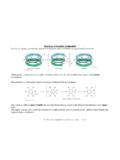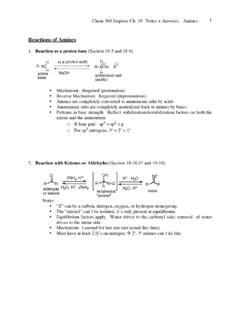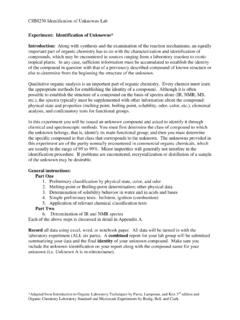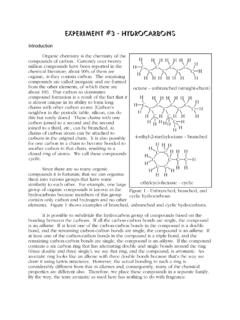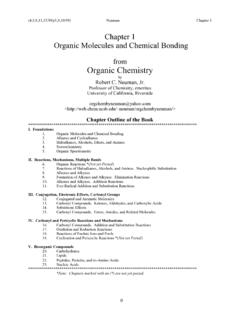Transcription of ACS Examination guide (Selected Questions) Organic ...
1 ACS Examination guide ( selected Questions). Organic Chemistry Nomenclature 1. What is the IUPAC names for this compound? a) 1-tert-butyl-2-butanol b) 5,5-dimethyl-3-hexanol c) 2,2-dimethyl-4-hexanol d) 1,1,1-trimethy-3-pentanol is the IUPAC name for this structure? a) 3-bromo-4-methylheptanone b) 5-bromo-4-methylheptanone c) 5-bromo-4-methyl-3-heptanone d) 3-bromo-4-methyl-5-heptanone 9. What is the IUPAC name of this compound? a) m-hydroxy-m-xylene b) 3,5-dimethylphenol c) 2,4-dimethyl-6-hydroxybenzene d) 3-hydroxy-5-methyltoluene Answer: 1, b; 4, c; 9, b. Structure, Hybridization, Resonance, Aromaticity Chapter Book p 17,18,19. 1) identify the lowest-energy Lewis structure for nitrogen oxide. (Formal charges not shown.). 8) The heat of combustion (per CH2) of several cycloalkanes is listed below.
2 Based on the data given, which of these cycloalkanes would be considered most stable. a) cyclobutane b) cyclopentane c) cyclooctane d) cyclopentadecane 11) Which pair consists of the resonance structure? Answer: 1, c; 8, d;11, a Organic Chemistry (/ Organic -chemistry/practice-problems) / Factors Affecting Acidity Overview (/ Organic - chemistry/factors-affecting-acidity). Acid and Videos Concept Bases(/ Organic -chemistry/factors-affecti ng-acidity). Book P 30, 31 Solutions 28. 1. Which structure corresponds to the predominant form of this molecule near pH 7? 1x 2x Solution: Which is the order from the strongest acid to the weakest question Which 4. is the Which order is the fromfrom order the strongest acid toacid the strongest the weakest acid for these to the weakest species?
3 Acid for these species? A) II > IV > I > III. B) III > I > IV > II. C) III > IV > I > II. D) II > I > IV > III. 8) Which of the indicated protons in this compound would have the smallest pKa values? Answer: 1, c;4, a;8, d. Stereoisomerism Book P38, 39, 1) Which molecule has the R configuration? 6) Which Newman projection represents the most stable configuration of (CH3)2 CHCH(CH3)2. 10) Which diastereoisomer is most stable? Answer: 1, c; 6, c, 10, b. Nucleophilic substitution and Elimination 2) When 2-bromo -2-methybutane is treated with a base, a mixture of 2-methyl-2-butene and 2-methyl-1-butene is produced When potassium hydroxide is the base, 2 methyl-1-butene accounts for 45% of the mixture, but when potassium tert-butoxide is the base, 2 methyl-1-butene accounts for 70% of the mixture.
4 What would you predict for the percent of 2 methyl-1-butene in the mixture if the potassium prop-oxide were the base? (a) Less than 45%. (b) 45%. (c) between 45% and 70%. (d) more than 70%. 11) Why would the concentrated hydrobromic acid be an inappropriate catalyst for the dehydration of alcohols? a) HBr is too weakly acidic to protonate the alcohol. b) The conjugate base, Br - , is a good nucleophile and it would attack the carbocation to form an alkyl bromide. c) HBr is strongly acidic, so the water molecule would not be a good leaving group after protonation of the alcohol. d) HBr would be more likely to promote rearrangement of the carbocation intermediate. 17) What would be the first step in the dehydration of cyclohexanol in sulfuric acid?
5 A) loss of OH - b) loss of H+ by the alcohol c) formation of a sulfite ester d) protonation of the alcohol Answer: 2, c, 11, b, 17, d. Electrophilic Additions 7) which set of the reagents will carry out the conversion shown? Answer: 7, c Nucleophilic Addition at Carbonyl Groups 8) which compound would be most rapidly hydrolyzed by aqueous HC to give methanol as one of the products? 12) which is the best reagent for this conversion? 17) which reagent will accomplish the conversion shown? Answer: 8, d, 12, b, 17, d. Nucleophilic substitution at Carbonyl Groups 1) This reaction that is typical of carboxylic acids, ester, acid halides, anhydrides, and amides is called. (a) nucleophilic non-acyl substitution (b) nucleophilic addition (c) nucleophilic acyl substitution (d) electrophilic substitution 3) Which would be hydrolyzed most slowly with aqueous NaOH?
6 13) Which reaction sequence is preferred for this conversation? Answer: 1, c, 3, a, 13, b. Enols and Enolate Ion Reactions pg. 97. 16) The first two steps in the base-catalyzed condensation of acetaldehyde would be described as: . D) OH abstracts the hydrogen atom from the carbonyl carbon, the then resultant anion attacks the carbonyl carbon atom on a second molecule of acetaldehyde. 20) Which represents a keto-enol tautomerization? 24) What is the product formed from this reaction? Answer: 16, c; 20, d; 24, d. Electrophilic and Nucleophilic aromatic Substitutions 1. Which substituents would deactivate benzene toward electrophilic aromatic substitution reaction? 4. Which set of reagents would most likely bring about this transformation? Answer: 1, b; 4, a.
7 Free-Radicals substitution and Additions 1. Which radical is the least stable? 5. What is the expected product of this reaction? Answer: 1, b; 5, c. Oxydation and Reduction pg. 138. 1. which reagents are best for carrying out this reaction? 3. Which reagents would best accomplish this transformation? 6. reduction of a triple bond to a E (trans) double bond can be accomplished with wich set of reagents? Answer: 1, a; 3, c; 6, a. Spectroscopy 1. Which ketone will show a carbonyl absorption at the lower frequency (cm-1) in the infrared? 3. Which is the reasonable structure for a compared with this IR spectrum? 5. Which structure is most consistent with this IR spectrum? Answer: 1, b; 3, a; 5, d. Synthesis and Qualitative Analysis 12. Which would be a suitable solvent for the preparation of ethyl-magnesium bromide from ethyl bromide and magnesium?
8 14. Which reaction sequence might be used to synthesize this compound? Answer: 12, c; 14, a.

